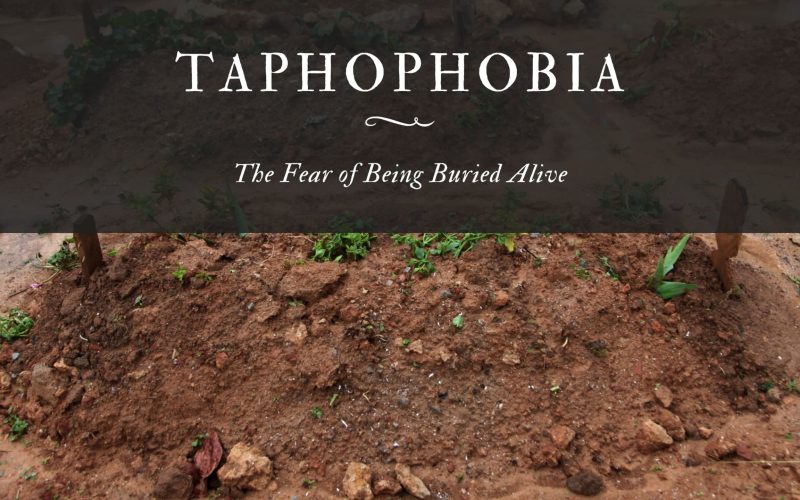A phobia can be defined as an unrealistic or unreasonable fear of a particular object, place, or thing, and this can lead to the patient desperately trying to avoid that which they fear.
In most cases, people who have phobia experience unnecessary panic and anxiety attacks.
According to the American Psychological Association(APA), a phobia can be classified as an anxiety disorder.
Taphophobia falls under the category of a specific anxiety disorder. Taphophobia can be defined as the irrational fear of graves.
Taphophobia comes from two Greek words; “taphos,” meaning “grave,” and phobia, meaning “fear”.
Most people who have taphophobia often avoid anything that has to do with burials or having to be near any hole dug in the ground.
Taphophobia can also be called taphephobia. Most people who have taphophobia have been discovered to have developed some other forms of phobia, such as thanatophobia (which is the fear of death), placophobia (which is the fear of tombstones), coimetrophobia (which is the fear of burial grounds), and claustrophobia (which is the fear of closed and tight spaces).
Taphophobia is quite a common phobia, as research has shown that certain celebrities have developed this anxiety disorder.
Among such celebrities are poets Edgar Allan Poe and George Washington, Composer F. Chopin, and Christian Hans Anderson, a writer.
Allen Poe, a famous writer, was alleged to have been so obsessed with this fear of graves that it began to take reality in some of his books, such as The Premature Burial, The Fall of the House of Usher, and so on.
Causes of Taphophobia
In ancient history, there had been several cases that have been documented of people who were mistaken to be dead and have been buried alive due to the lack of adequate medical facilities, types of equipment, and medicines to check if these people were actually dead before burial was done.
Sometimes, people who are in a coma or those suffering from certain dangerous diseases such as cholera who probably had no pulse or had passed out were buried alive.
Some who were not buried alive found out after they regained consciousness that they had been pronounced dead.
A series of these incidences were predominantly prevalent during the 19th and 20th centuries, and as such, this phobia was recorded to have begun in people during that time.
In that era, coffins were made with bells so that if anyone was mistakenly buried alive, he or he could ring the bell and be dug up.
This birthed the phrase “saved by the bell.” Along with the invention of the bell in the coffin, other techniques were put in place to “help” a person who was previously presumed to be dead and alert outsiders.
Some of such inventions include using oxygen tanks, applying air pipes that were passed into the coffin, and using glass doors in place of wooden doors, amongst others. Death is one terrifying word. To many, it is strange, unknown, and unexplored.
No one knows what happens after death or if there is any truth to the reality of life after death.
The anxiety to know what happens after death can lead to the development of thanatophobia as well as taphophobia.
Most people who have suffered or are suffering from taphophobia have been seen to be suffering from other phobias, too.
Often, they develop taphophobia as the secondary phobia while another phobia, for example, thanatophobia, presents as the primary phobia.
According to research, 70% of people who have taphophobia are miners. Most miners have seen or had negative experiences of people who have mistakenly been trapped underground, and these experiences often account for the cause of their phobia.
Aside from miners, people who have had other traumatic experiences, such as being buried in the sand on the beach and left there for hours in a bid to have fun or make fun of the individual buried, can result in the development of taphophobia.
Likewise, parents can unknowingly instill the fear of being buried alive into their children.
Another example of things that can result in the development of taphophobia is the type of things people see. Books and movies are a top contributing development factor in a person’s life.
Hence, a person can develop taphophobia after a series of books, TV shows, or movies he or she has seen.
Symptoms of Taphophobia
Our thoughts can significantly affect how we react to things and situations around us. Thoughts of being buried alive can produce so many physical and psychological symptoms.
A person who suffers from taphophobia may experience the following symptoms;
Physical Symptoms
- Difficulty in breathing
- Trembling and tremors.
- Intense sweating
- Severe headaches
- Irregular heartbeats
- Rapid pulse rates
- Uneasiness
- Lack of bowel control
- Lack of concentration
- Lack of coordination
- Restlessness
- Outbursts of emotions (mostly anger)
- In children, incessant crying
- Screaming
Psychological Symptoms
Most people who have taphophobia often experience one significant symptom, which is Avoidance.
People who have taphophobia always have an intense desire to avoid their fears. To them, it is an effective coping mechanism that has worked so well so far.
As such, as one of their symptoms, a person who suffers from taphophobia tends to avoid enclosed spaces such as underground places, caves, basements, and so on.
Also, places such as cemeteries, tombstones, or underground caves are a no-go area for people who suffer from taphophobia.
Some wealthy patients may go the extra mile to make elaborate arrangements for the designs of their coffins.
Some may require the use of air pipes, placing oxygen tanks or heart stimulators into their coffin when they are buried to ensure that if, for any reason, they were mistakenly buried alive, they can always survive the harshness of the grave before help comes.
According to research, some patients have asked not to be buried immediately after they are dead to ensure that they are ‘properly’ dead before they are buried.
Most patients who suffer from taphophobia generally love to sometimes be on their own. Because of their fears, they may appear weird to others around them, leading to them being constantly made fun of and bullied.
It is essential to understand that people who have taphophobia are not strange. They are normal humans like us who have an exaggerated fear of graves.
As such, it is unfair to start bullying them as this further increases their anxiety and might cause them to slip into depression.
Treatment
Knowing their fears and how disruptive they can be to their everyday lives, it is often recommended that patients who suffer from taphophobia should seek professional and medical help to help them understand the false realities that they live in and also provide ways for them to come out of it.
It is always advised that if you are experiencing phobias of any kind, it is important to visit your doctor.
Your doctor will ask questions to help determine what is wrong. After this, your doctor may refer you to a therapist who will further evaluate you to determine the type of fear you have.
Treatment often comes in three ways:
Therapy
Therapy often includes your doctor asking you questions. It is often best to answer these questions as truthfully as possible, as it helps him/her determine what is wrong with you. There are so many types of therapy sessions you may be asked to undergo.
However, according to research, two of these therapy methods have been seen to be very effective:
Cognitive Behavioral Therapy
Cognitive Behavioral Therapy, mostly known as CBT, is one of the most common therapies used to treat phobias and has been seen to be the most effective.
It is based on the speculation that our behaviors are constantly influenced by the things we see and perceive.
This is why, most of the time, the things you see and perceive to be true can become your new reality even though, in some cases, they are false.
Whenever we experience anxiety and phobias, it causes a disruption in our brain patterns, perceptions, and thought processes. As such, most of the time, the realities our brains offer us aren’t the actual reality.
It is this distortion in our thought processes that CBT seeks to correct. Cognitive Behavioural Therapy aims to help a patient realize that their fears aren’t the actual reality.
CBT involves using strategies to help the patient identify their false realities and new methods to seek the actual truth.
For example, if you have taphophobia, your therapist will help you identify your fears and show you a contrast in reality through CBT.
This can make you realize that what you initially perceived to be true isn’t the reality, and as such, you can now see why you need a change of perception.
Exposure Therapy
Exposure therapy is a common form of treatment by which the patient is gradually exposed to his/her fears; however, it must be in a controlled environment.
For patients who have Thaphophobia, your therapist may begin to introduce you to the ideas of tombstones and graves. He or she may start by showing you pictures of several monuments.
Depending on the patient’s response, your therapist may introduce the patient to a higher level of fear.
This method helps desensitize the patient by showing him or her that his or her fears are nothing more than fears.
Hypnotherapy
Hypnotherapy is not a usual form of treatment for phobias. However, records have shown that the use of hypnosis has been very effective in treating specific phobias, including taphophobia.
Often, hypnosis is combined with NLP (NeuroLinguistic Programming), which is mostly used to determine the root cause of the problem.
These forms of therapy help to reprogram the mind of the patient such that he or she has a more positive attitude and response to their phobia.
Another benefit of these forms of therapy is that they also help the patient overcome depression and stress, which may be the initial trigger of this phobia.
The Use of Medications
For some people who are suffering from taphophobia, therapy may not be enough, and as such, your doctor may need to prescribe that you use certain medications.
These drugs may include benzodiazepine, antidepressants, as well as anti-anxiety medications.
Self-help
Self-help processes refer to some methods that you can use in the comfort of your home to help relieve your anxiety.
Examples include yoga and meditation. It is said that Yoga and meditation help to refocus the mind and also help the body relax, thus eliminating anxiety and panic attacks.








